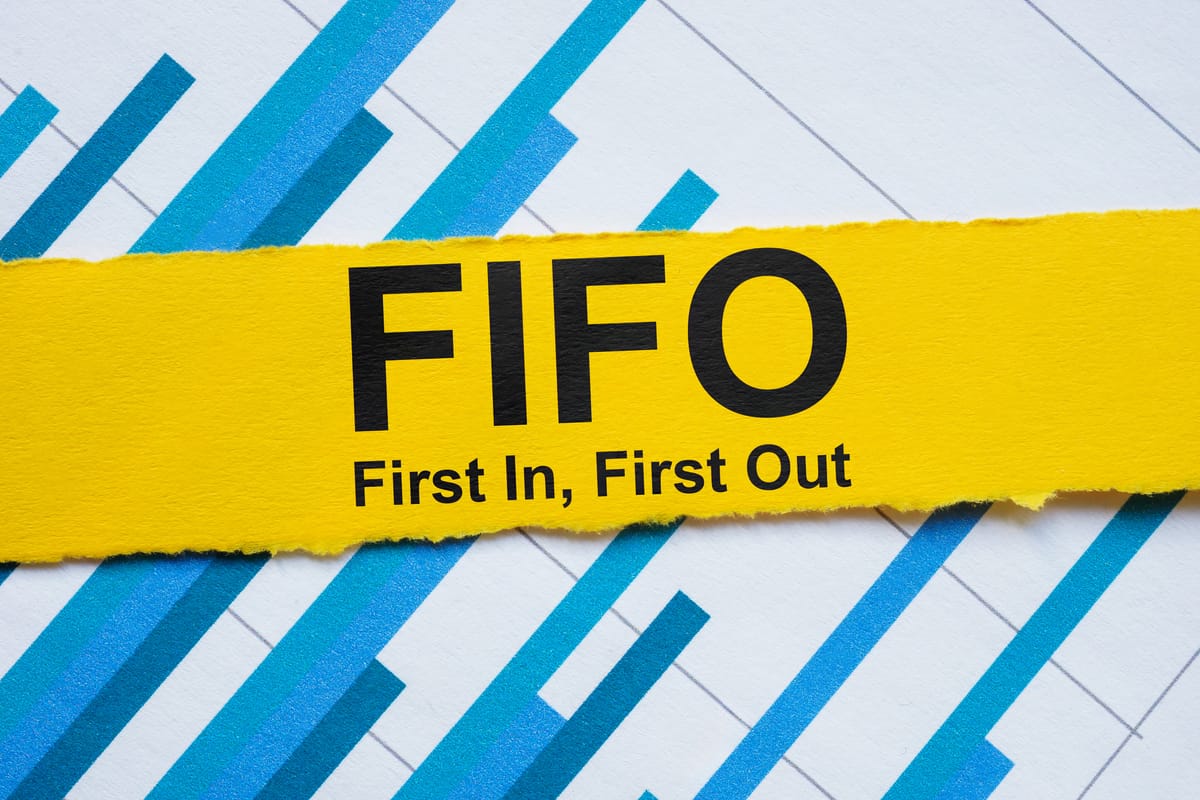What is FIFO? Basics, Benefits, and Tips

Imagine stepping into the storeroom of your local grocery store. As you scan the neatly organized shelves, you notice the oldest canned goods and produce strategically placed at the front, ready to be sold first. This deliberate arrangement isn’t just practical wisdom; it's an effective inventory management method known as FIFO.
FIFO, which stands for First-In, First-Out, is a method of inventory valuation that assumes the oldest products in your stock are sold first. It's a widely used approach that helps businesses of all sizes, from small specialty food shops to large supermarket chains, keep a close eye on their inventory and finances.
Keep reading to explore a detailed explanation of how FIFO works, its numerous benefits, and practical tips and examples to get started.
What is the FIFO method?
FIFO, or First-In, First-Out, is an inventory valuation approach that tracks and accounts for the movement of goods through a business's stock. The underlying principle is simple: the items that are produced or purchased first are the ones that are sold or used first.
This strategy is particularly crucial for products that deteriorate over time, such as perishable goods, medications, and seasonal fashion items.
Impact on Financial Statements
To understand how FIFO affects financial reporting, it's essential to define two key financial statements:
📌 Income Statement
This financial document summarizes a company's revenues and expenses over a specific period, typically a quarter or year, to show the net profit or loss. It includes costs like the Cost of Goods Sold (COGS), which directly impacts the company's profitability.
📌 Balance Sheet
This statement provides a snapshot of a company's financial condition at a specific point in time. It lists assets, liabilities, and shareholders' equity. The way inventory (an asset) is valued can significantly affect the overall asset values listed on the balance sheet.

Here's how FIFO impacts these financial statements:
- Income Statement: In environments where prices are rising, FIFO results in older, cheaper inventory costs being accounted for first. This method shows a lower COGS, leading to higher gross profits and, consequently, higher net income during inflationary periods.
- Balance Sheet: Since FIFO leads to the sale or use of the oldest inventory first, the newer, more expensive items remain in stock. Therefore, the inventory on the balance sheet is valued at more recent costs, which are typically higher. This results in a higher total asset value on the balance sheet, which can be beneficial for businesses when seeking credit or investments.
By employing FIFO, you can manage your inventory more effectively and optimize your financial reporting, especially in fluctuating economic climates.
How FIFO Works
The FIFO method operates on the principle that the oldest inventory items are the first to be sold or used. This means that when a customer purchases a product or a company uses an inventory item, the cost of the earliest acquired goods is recorded as the cost of goods sold (COGS).
Here's a step-by-step overview of how the FIFO method works in day-to-day inventory operations:
- When new inventory is received, it is added to the existing stock, with the oldest items placed at the front and the newest items at the back.
- As products are sold or used, the cost of the oldest items in the inventory is recorded as the cost of goods sold.
- The value of the remaining inventory on the Balance Sheet reflects the cost of the most recent purchases, while the cost of goods sold on the Income Statement reflects the cost of the oldest items that were sold.
By ensuring that the oldest items are sold or used first, businesses can minimize the risk of spoilage, waste, and lost sales due to outdated inventory.
FIFO Formula
The FIFO (First-In, First-Out) method follows a straightforward principle for calculating inventory costs. The formula primarily focuses on the cost of the oldest inventory, which is first matched against revenue when calculating the cost of goods sold (COGS).
This method ensures that the costs associated with the oldest inventory are used first when calculating COGS, leaving the newer inventory costs for future sales or inventory valuation.
Let's define the key components for using this formula:
- Starting Inventory: The value of the inventory at the beginning of the accounting period, carried over from the previous period.
- Purchases During the Period: Additional inventory acquired during the accounting period, often at varying costs due to market conditions.
- Ending Inventory: The value of the inventory remaining at the end of the accounting period after accounting for sales.
- Cost of Goods Sold (COGS): The total cost of the inventory that was sold during the period, calculated using the FIFO method by selling the oldest stock first.
- Gross Profit: The difference between the sales revenue and COGS, representing the profit before accounting for operating expenses and taxes.

Step-by-Step Calculation: An Example
Let’s walk through a detailed example to illustrate how FIFO is applied:
1. Starting Inventory:
A company begins with 200 units in inventory, purchased at $5 each. The starting inventory value is $1,000 (200 units × $5).
2. Purchases During the Period:
The company buys another 300 units at $6 each and later another 500 units at $7 each. This results in additional inventory purchases of:
- First Purchase: $1,800 (300 units × $6)
- Second Purchase: $3,500 (500 units × $7)
3. Sales During the Period:
The company sold a total of 600 units during the period.
4. COGS Calculation:
- Sell the first 200 units from the starting inventory: 200 units × $5 = $1,000.
- Sell the next 300 units from the first purchase: 300 units × $6 = $1,800.
- Sell the remaining 100 units from the second purchase: 100 units × $7 = $700.
- Total COGS: $1,000 + $1,800 + $700 = $3,500.
5. Ending Inventory:
- Remaining inventory is 400 units from the second purchase, valued at $7 each.
- Ending Inventory Value: 400 units × $7 = $2,800.
6. Gross Profit Calculation:
- If the company sold the 600 units at $10 each, the total revenue would be $6,000.
- Gross Profit: $6,000 (Revenue) - $3,500 (COGS) = $2,500.
5 Benefits of the FIFO Method
According to Credit Suisse Group AG, which analyzed annual reports from 2021 and 2022, approximately 55% of S&P 500 companies primarily utilized FIFO for their inventory management. In contrast, around 15% employ LIFO, while the remaining companies adopt other methods like the average-cost method or a combination of various approaches.
Adopting the FIFO inventory management approach can give your business a range of advantages. Let's explore some of the key benefits:
1. Reduced Inventory Costs and Waste
By ensuring that the oldest inventory items are sold or used first, FIFO helps minimize the risk of expired, obsolete, or spoiled goods. This, in turn, leads to lower inventory carrying costs, reduced waste, and improved overall efficiency. Businesses can avoid the financial burden of holding onto inventory that is no longer useful or profitable.
2. Accurate Financial Reporting
FIFO's impact on the income statement and balance sheet ensures that your financial records accurately reflect the current value of your inventory and the true cost of goods sold. This level of financial transparency can be invaluable when making strategic business decisions, as you'll have a clear understanding of your company's financial standing.
3. Improved Cash Flow and Profitability
By recognizing the cost of the oldest inventory items first, FIFO can help maximize your profitability, especially in times of inflation. This is because the more recent, higher-cost inventory items remain on the balance sheet, leading to a higher gross profit margin on the income statement. In 2021 and 2022, about 30 U.S. companies switched from LIFO to FIFO to enhance profitability under inflationary pressure.
4. Enhanced Inventory Turnover
The FIFO method encourages a consistent flow of inventory, with the oldest items being sold or used first. This can result in improved inventory turnover rates, which is a key indicator of operational efficiency and overall business health. Faster inventory turnover can also lead to better cash flow and more responsive supply chain management.
5. Compliance with Accounting Standards
FIFO aligns with the widely recognized accounting principles of GAAP (Generally Accepted Accounting Principles) and IFRS (International Financial Reporting Standards). Adhering to these standards can simplify your financial reporting and ensure regulatory compliance, which is essential for maintaining the trust of investors, lenders, and other stakeholders.

FIFO Best Practices: 4 Actionable Tips & Strategies
Implementing the FIFO method effectively requires a holistic approach that considers your business's accounting and inventory management aspects. Here are some best practices to keep in mind:
1. Organize and Label Storage Spaces
Proper organization of your storage space is vital for FIFO success. Products should be arranged to make older items easily accessible, ensuring they are used or sold before newer inventory.
- Arrange products by arrival date, placing older inventory at the front and newer items at the back.
- Use clear labeling with dates and other relevant information to help staff quickly identify the items to pick first.
- Consider using color-coded labels or signs to distinguish different batches or arrival dates, making implementing FIFO in a busy warehouse easier.
2. Leverage Technology and Inventory Software
Invest in reliable inventory management software that can track and trace your inventory movements, automating the FIFO process and reducing the risk of human error. This can provide real-time visibility into your stock levels, expiration dates, and item histories, empowering your team to make informed decisions about inventory rotation and sales.
You should opt for a tool that uses barcode scanners or RFID technology to keep track of inventory movements and ensure that the oldest stock is always prioritized for use or sale. Make sure that the tool also allows you to set up automated notifications to alert staff when certain batches are nearing their expiration or need to be sold first.
• Real-Time Tracking: Provides live updates on inventory, making it easy to prioritize older items.
• Barcode Scanning: Streamlines transactions with barcode scanning, automatically applying FIFO principles.
• User-Friendly Interface: Accessible on both PC and mobile, making it easy for teams to manage inventory across different locations.
These features help businesses efficiently manage inventory, reduce waste, and maintain accurate records.
3. Regularly Review and Audit FIFO Processes
Establish a routine for reviewing and auditing your FIFO practices. This will help you identify any areas for improvement, ensure adherence to your established procedures, and make adjustments as needed to maintain optimal efficiency. Regular cycle counts, physical audits, and reconciliations can help you keep your FIFO system running smoothly.
4. Integration of Accounting and Inventory Management
For the FIFO method to be truly effective, it's essential to consider your business's accounting and inventory management aspects. Your accounting team should work closely with your inventory managers to ensure that the financial records accurately reflect the physical movement of goods and that any discrepancies are quickly identified and resolved.

Companies Using FIFO: Case Studies and Examples
Several companies across different industries have successfully implemented the FIFO method, benefiting from improved inventory management, reduced waste, and better financial outcomes. Here are a few case studies and examples:
Walmart: The Retail Giant's Fresh Approach
Walmart, the retail powerhouse, has embraced FIFO to keep its vast inventory in check. By making sure the oldest items hit the shelves first, Walmart keeps its products fresh and its financial reports accurate. This strategy has helped them cut down on waste, keep cash flowing, and stay on the right side of accounting rules.
Pfizer: Keeping Medicine Safe and Effective
In the world of pharmaceuticals, Pfizer uses FIFO to manage its inventory of drugs and medical supplies. By keeping a close eye on expiration dates and selling older batches first, Pfizer ensures that customers receive safe, high-quality products. This approach has helped Pfizer reduce waste and keep regulators happy.
Nestlé: Serving Up Freshness Worldwide
Nestlé, the food and beverage titan, has rolled out FIFO across its global supply chain. By prioritizing the sale of older stock, Nestlé keeps its products fresh and customers satisfied. This strategy has helped Nestlé cut down on spoilage, keep money flowing smoothly, and maintain its reputation for quality.
Other Methods: FIFO vs. LIFO vs. WAC
When managing inventory, businesses often choose between several methodologies, primarily FIFO, LIFO (Last-In, First-Out), and WAC (Weighted Average Cost). Understanding the differences can help decide the best approach based on financial goals, tax implications, and industry standards.
Last-In, First-Out (LIFO):
While FIFO ensures the oldest stock is used or sold first, under Last-In, First-Out (LIFO) method, the most recently produced or purchased items are recorded as the first ones sold.
- How it works: LIFO assumes the most recently acquired inventory is sold first. This method can be advantageous in industries where inventory costs are rising, as it matches the higher cost of newer items against current revenue.
- Impact on financial statements: LIFO results in a higher COGS, which can lower taxable income and, consequently, the tax burden. However, it can also lead to lower inventory values on the balance sheet, potentially underrepresenting the actual current asset value.
- Example: An oil company might use LIFO to manage its inventory of fuel. Since fuel prices can be volatile, using LIFO allows the company to report lower profits by attributing higher costs to sold inventory, which can be beneficial for tax purposes during inflationary periods.
Weighted Average Cost (WAC):
The WAC method calculates the cost of goods sold and the value of the ending inventory based on the average cost of all units available for sale during the accounting period. This approach provides a middle ground between FIFO and LIFO, but it may not offer the same level of precision in tracking the flow of specific inventory items.
- How it works: WAC calculates the average cost of all items in inventory and applies this average to determine COGS. This method smooths out price fluctuations, offering a middle-ground approach.
- Impact on financial statements: WAC results in a more consistent COGS and inventory valuation, providing a balanced approach that doesn’t skew too heavily towards high or low profit margins. It’s particularly useful for businesses with homogenous inventory where tracking individual costs isn’t practical.
- Example: A manufacturing company like a furniture producer might use WAC to manage its raw materials inventory. With materials bought at different times and prices, WAC allows for a straightforward, averaged cost that simplifies accounting and financial reporting.
👉 Select FIFO if your business deals with perishable goods or items that lose value over time.
👉 Choose LIFO if you operate in an environment with rapidly increasing prices and want to reduce tax liability.
👉 Opt for WAC if you manage a large volume of similar items where individual tracking is unnecessary.
Final Thoughts: FIFO for Optimal Inventory Management
FIFO, or First-In, First-Out, is a method of managing inventory that ensures the oldest items are sold first. This approach helps businesses avoid waste and maintain accurate financial records, especially when product prices rise. It also keeps inventory orderly and in compliance with important accounting standards like IFRS and GAAP.
For businesses looking to implement FIFO effectively, adopting technologies like BoxHero can be transformative. BoxHero automates and simplifies inventory processes, supports real-time tracking, and offers a user-friendly interface.
RELATED POSTS








